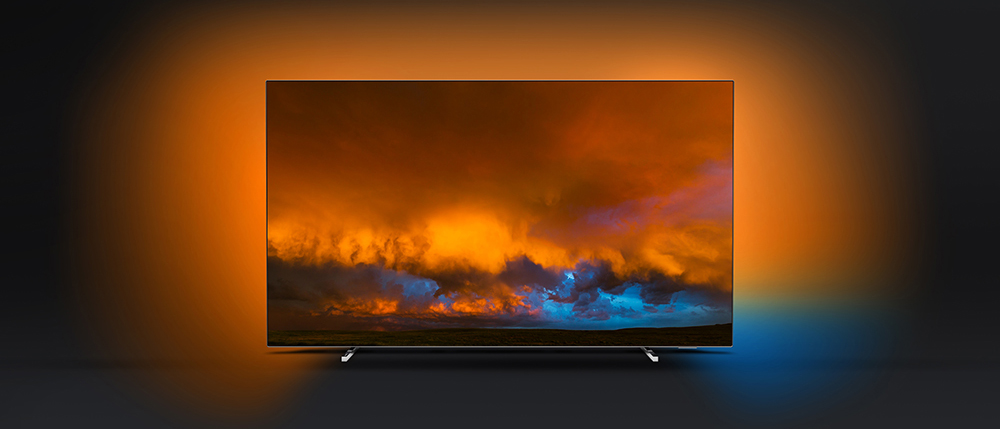TechRadar Verdict
Pretty much all of the improvements Philips has conjured up for its latest OLED TV yield stellar results. Pictures look more subtle and refined, sound benefits from new built-in Dolby Atmos decoding, and the set’s extra processing power even manages to make the latest version of Android TV feel less unhelpful than usual.
Pros
- +
Outstandingly wide-ranging HDR support
- +
Immersive Ambilight design feature
- +
Beautifully sharp, contrast-rich pictures
- +
Great value
Cons
- -
Complicated to use
- -
Sound lacks bass
- -
Various Android TV issues
- -
Vivid mode causes clipping
Why you can trust TechRadar
The Philips 55OLED804 arrives in our test rooms boasting key new HDR format support, and fresh from its success at the Expert Imaging and Sound Association (EISA) awards, where it picked up the coveted title of Best Buy OLED TV. This award focuses on value for money – and the more time you spend with Philips’ latest OLED model, the easier it becomes to see why EISA liked it so much.
We first got a look at the OLED 804 and 854 models back at CES 2019, though the only different between these two products is the TV stand.
Design
The Philips 55OLED804 doesn’t look remotely like a ‘value’ TV. In fact, every aspect of its design feels premium, from its metal-dominated finish to its ultra-narrow frame, (mostly) super-slim rear, and the way it sits directly on top of a pair of gleaming metal feet.
The Philips logo is elegantly engraved into one of the feet, and since the feet jut straight out, and are only around a centimetre or so in diameter when viewed front-on, you can barely see them when you're sitting directly opposite the screen. We can’t think of any other TV that works so hard to remove hardware distractions from the pictures it’s showing.
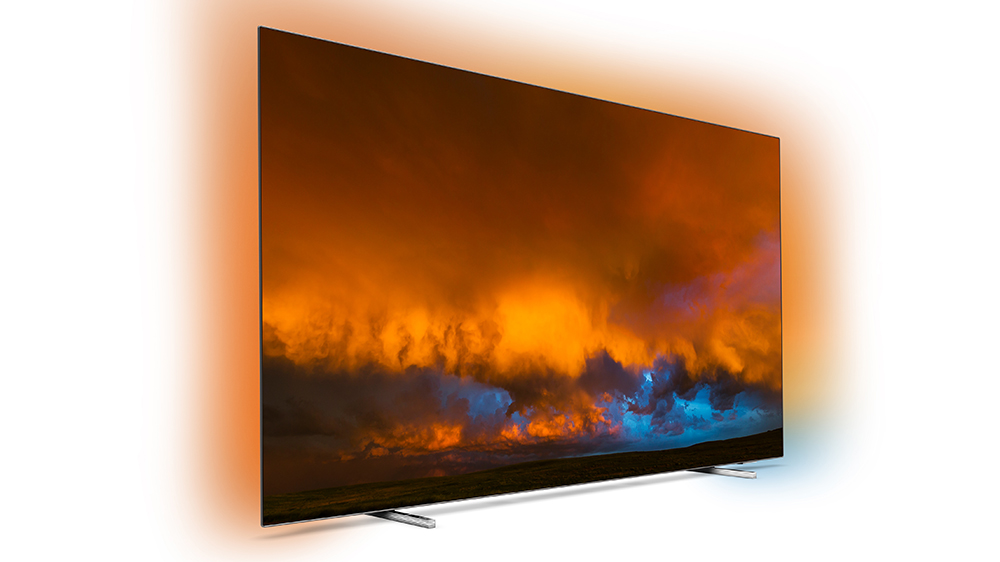
You might think the inclusion of Ambilight on the 55OLED804 would run counter to the set’s generally ultra-minimalistic design. After all, the way Ambilight’s rear-mounted LEDs boldly cast coloured light from three of the set’s edges is guaranteed to distract you from the picture, right? Actually, no. Provided you’re sensible about how you set Ambilight up (don’t leave its brightness too high, and don’t set it to track image content too aggressively), it actually enhances your immersion in the pictures you’re watching.
The 55OLED804’s unique approach to design extends to its remote control. This carries a full QWERTY-based keyboard on its rear, making it easier to input text when setting up streaming app accounts, accessing web pages or instigating online searches.
Design TL;DR: The 55OLED804’s excellent build quality and minimalistic aesthetic mean it doesn’t draw undue attention to itself when you’re watching it, and becomes a gorgeous addition to your living room when you’re not. And as ever, Ambilight, if used carefully, is an experience-enhancing pleasure most people find hard to live without once they’ve tried it.
Smart TV features
Philips has been using Google’s Android TV platform on its premium TV models for a few generations now. This makes sense for a brand which perhaps doesn’t have the streaming-deal negotiating clout some of its rivals do. It also means, though, that Philips is exposed to Android TV’s issues, namely a rather clunky and confusing interface, lots of lengthy firmware updates, a deluge of apps that most TV users won’t give two hoots about, and a relative shortage of customisation options.
The good news is that with its latest Oreo implementation, Android TV has started to get on top of its problems. It’s much less buggy than it used to be; it does a much more effective job than before of highlighting key video content; it runs more slickly; and here it doesn’t seem to cause sluggishness in other areas of the TV menus. More stuff goes on in the background than before, leaving you less likely to find yourself sitting there watching an update bar crawling along. And there’s at least a degree of customisation now.
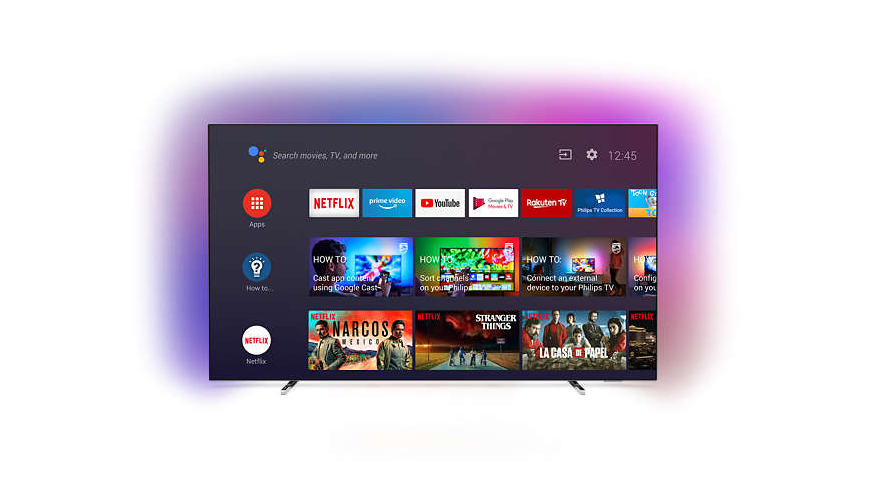
There’s 4K and HDR support from key apps such as Netflix, Amazon Prime Video, Google Play and YouTube, too. Unfortunately, though, there’s still no support via Android for the All4 and My 5 catchup services of Channel 4 and Channel 5. And nor does the 55OLED804 provide support for either the Freeview Play or YouView apps that might have given you a way of accessing these absent catch-up platforms.
The Android TV approach does provide built-in Chromecast support, though, as well as Google Assistant voice control.
One final positive point to note about the 55OLED804’s video streaming is that it will deliver the premium dynamic HDR performance available from any streaming service, thanks to its support for both of the HDR10+ and Dolby Vision formats.
Smart features TL;DR: Android TV is finally morphing into a decent smart TV system, thanks to better content management and customisation options. It’s relatively stable on Philips TVs, too. There’s still a way to go, though, before it becomes as friendly to use as its rivals.
HD/SDR picture quality
Philips has always been particularly good at adding detail and sharpness to HD pictures when upscaling them to 4K. With the 55OLED804, though, it’s also managed to make upscaled pictures look more natural than before, without significantly compromising the previous trademark sharpness.
The main reason for this appears to be the new noise detection and reduction systems Philips has introduced to its latest P5 video processor. The 55OLED804 seems markedly better at identifying the difference between unwanted noise and ‘real’ picture information in sub-4K sources, and so is more successful at increasing the resolution in the real stuff while throwing out the rubbish.
The 55OLED804’s upscaler also seems to be more intelligent about how aggressively it does its work in different areas of the picture, building a more organic, realistic, depth-enhancing image, rather than just upscaling the entire picture on a less effective ‘one processing size fits all’ basis.
There’s a smoother, less jagged look to upscaled diagonal and curved lines too, and it’s great to see that the 55OLED804’s upscaling is clever enough to keep colour blends looking subtle and natural, without banding or blocking sneaking in. Motion doesn’t suffer with lag or smearing during upscaling, either.
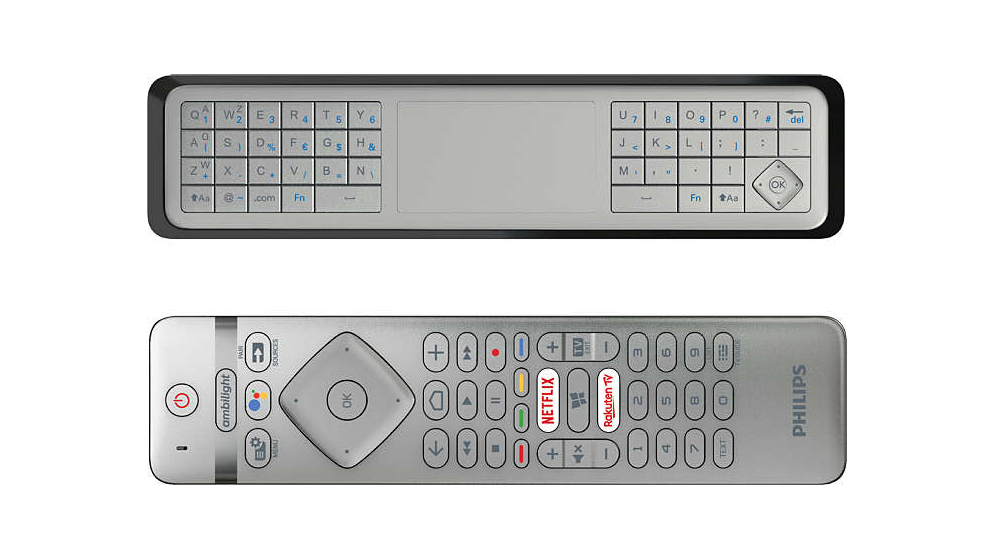
The 55OLED804 is also excellent at converting SDR sources to HDR. Again, the new P5 processor takes a more localised approach to its upscaling, working more aggressively on the colour saturation and brightness of some areas than others to retain a more authentic feel to the image than you’d get if you just applied a single formula to every colour and brightness level across a picture.
Colours typically enjoy a strong uplift in vibrancy without looking forced or splotchy, and the 55OLED804’s HDR upscaling does a particularly effective job of recognising small, bright highlights in SDR pictures and giving them a really authentic boost that does a strikingly effective job of creating a sense of HDR ‘pop’.
If your inner purist can’t cope with the idea of SDR being converted to HDR, then you’ll be pleased to hear that the 55OLED804 also does a beautiful job in native SDR mode (achieved by turning off the set’s Perfect Natural Reality processing). There’s gorgeous subtlety in the native SDR’s colour and contrast reproduction that reminds you of how much picture information SDR can contain in its limited colour and contrast range, provided a TV has the finesse to unpack it all. There’s often an almost painterly beauty to high-quality Blu-rays played in SDR mode, in fact.
HD/SDR Performance TL;DR: The Philips 55OLED804 is a brilliant handler of legacy video content, with the latest P5 engine making upscaled images look more natural than they have on previous Philips OLED TVs, and doing a better job with the lowest quality sources.
4K/HDR performance
Last year’s Philips OLED803 made its mark on the OLED TV world with the extreme aggression of its pictures. Colours looked stunningly vibrant, with wide-gamut images, and brightness peaks with HDR content were in a class of their own for OLED screen technology. For the 55OLED804, though, Philips has focused more attention on the finer things in life, dialing back the drama a touch – at least with the most successful picture presets – in return for a more sophisticated, subtle, and consistent experience.
Particularly welcome is the extra detail Philips has been able to pull out in dark HDR scenes. Such images could sometimes look a bit hollow and flat on last year’s otherwise-excellent OLED803 range, but the 55OLED804 brings out more subtle shading and low-level colour information. This helps dark scenes feel more consistent with neighbouring bright ones, and gives them more depth and naturalism.
The 55OLED804’s enhanced subtlety also plays into its colour performance. Blends, skies, skin tones and other notoriously difficult content looks more polished and refined, making you feel like you’re seeing that much more of the full detail the content’s creators were seeing on the megabucks mastering monitors they were creating it on – not a bad feeling to be getting on a 55-inch OLED TV that costs just £1,800.
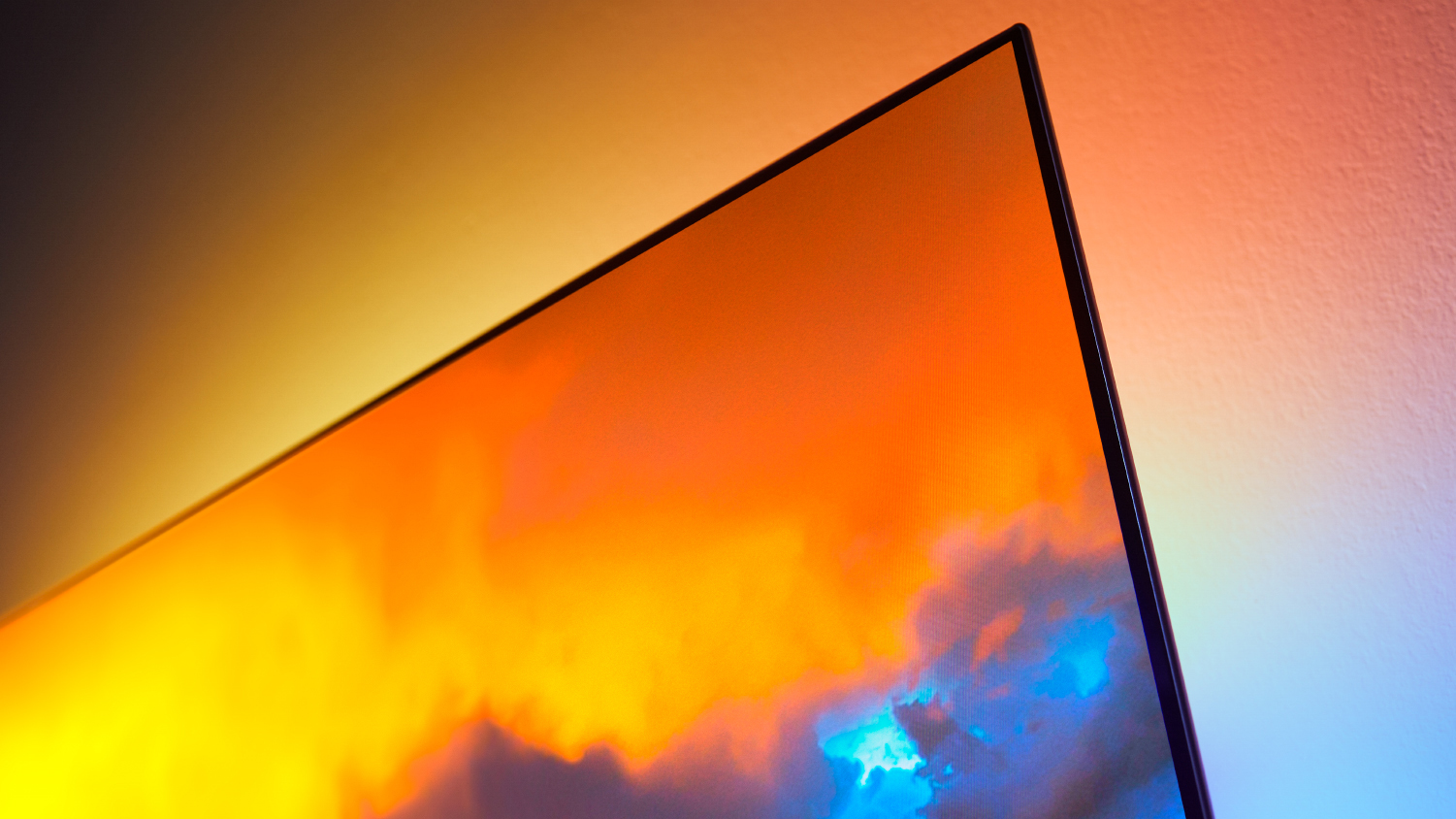
The 55OLED804 creates much more consistently natural skin tones than its predecessor, which tended to push HDR flesh towards excessive yellow or brown hues.
Philips has further refined its motion handling, too. On its highest level, Philips’ motion processing is still capable of the unique fluidity and detail retention that’s long been the brand’s trademark. Now, though, you can retain more of this fluidity and sharpness while suffering less of the unwanted processing side-effects that have traditionally accompanied Philips’ motion processing.
We still wouldn’t recommend using the highest setting for the motion system, especially with films. But there are now other options that really can deliver effective but also natural-looking judder and blur-reduction results.
While we said earlier that the 55OLED804’s pictures perhaps weren’t quite as aggressively dynamic and vibrant as those of its predecessor, they’re certainly not lacking in punch. Colours still look bold and rich, and there’s a strong average brightness level by OLED standards. There’s also still a strong intensity to subtle HDR highlights, such as gleams in people’s eyes or reflections on windows and metal. These highlights maybe don’t stand out quite so proudly from the rest of the image as they did on the OLED803 models, but that’s perhaps not a bad thing.
For the record, the 55OLED804’s Personal picture preset can briefly hit around 750 nits before dropping back to 640 nits on a 10% white HDR window. The Movie preset settles less punchily but more consistently on around 650 nits.
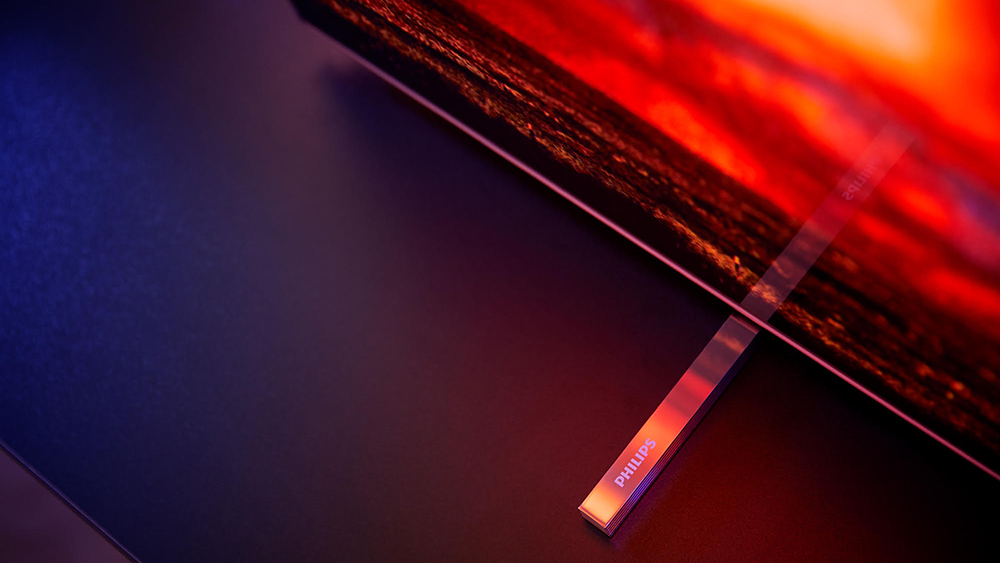
The Vivid preset that worked so well on the OLED803 series ups the HDR ante massively, briefly hitting 900 nits on our 10% white HDR window (a very high figure by OLED standards). It drops back to 770 nits shortly after hitting that 900 nit peak, but this is still a high figure for OLED, which translates into consistently bold-looking pictures.
On the 55OLED804, though, the Vivid mode comes with a string attached. For in pushing for that extra impact, it delivers some pretty noticeable clipping (loss of subtle detail and toning) in the brightest parts of the picture. This can make such white and colour highlights look plasticky, flat, and out of kilter with the high levels of detail and depth on show elsewhere.
This issue was problematic enough to make us turn to the 55OLED804’s less dramatic Personal picture preset, rather than typically sticking with Vivid, as we did with the OLED803.
This is unfortunate to some extent, given how exciting it was to experience such bold pictures on an OLED TV as those delivered by the OLED803’s Vivid mode. Perhaps Philips might be able to tweak the OLED804's Vivid mode via firmware over time; in any case, though, the lovely new finesse you get with the 55OLED804’s Personal preset arguably more than makes up for the slight disappointment of its Vivid HDR mode.
The 55OLED804 mines plenty of value from its 4K pixel count. Good-quality native 4K sources enjoy just the sort of extra depth of field, realism and texture that you’d hope to see versus HD screens. Sharpness has long been a Philips image trademark, but with the 55OLED804 there’s a difference in the way this sharpness presents itself. Here it feels more like the TV is eking out more of the finest details contained in the original content, rather than using clever processing to give lower levels of ‘real’ detail a sharper look. And that’s a good thing.

If you’re likely to be gaming on your next TV, the 55OLED804 looks like a fine option, given that it only takes around 15ms to render image data when running in its Game mode.
One last key point to cover with the 55OLED804’s pictures is its dual HDR10+ and Dolby Vision support. The set correctly identifies which of these two sources it's receiving, with no manual input required, and the resulting pictures benefit from the slightly more consistent dynamism and, in DV’s case, colour refinement that you’d expect to see from the extra scene-by-scene image data both formats provide.
Now that Philips and Panasonic are offering premium TVs that support both dynamic HDR formats, it’s surely going to become harder and harder for other brands to keep only supporting one or the other.
One quirk of the 55OLED804’s Dolby Vision support at the time of writing was a strange raised black level issue when using an Oppo 4K Blu-ray player. This did not occur with other brands of Dolby Vision 4K Blu-ray player, though, and Philips expects that it will be able to fix the problem via a firmware update.
One last picture point worth mentioning is that while Philips has got better with its out of the box settings this year, enthusiasts will still likely find themselves spending longer in the 55OLED804’s long and complicated picture option menus than they would with most TVs – on the other hand, though, it’s actually nice to see Philips providing so much control over so many of its picture features.
4K/HDR picture quality TL;DR: It’s a pity that the 55OLED804’s Vivid mode causes distracting amounts of clipping. Otherwise, the set’s 4K HDR pictures combine much of the richness and dynamism Philips is known for with a new and very welcome appreciation for the finer things in AV life.
Sound performance
The Philips 55OLED804 carries a built-in Dolby Atmos decoder, and boasts a promising 50W of total audio output. In some ways this combination works well – provided you activate the strangely optional Dolby Atmos Height Speaker option in the TV’s menus.
Dialogue is surprisingly clean and presents quite forwardly in the mix, despite the 55OLED804 not having forward-facing speakers.
The 55OLED804’s soundstage is wide and engaging, and the speakers are powerful and open enough to deliver plenty of clean, well-placed details. Certainly you don’t get the usual boxed-in, lifeless sound still associated with many flat TVs; impressive stuff for a TV that’s so stylish and trim.
There are, though, limits to what the 55OLED804’s audio system can do. For instance, while the sound spreads away from the TV it doesn’t really fill your room, or immerse you in the heart of the audio action.
The 55OLED804 also doesn’t have enough bass to give its sound the sort of strong foundation it really needs. The result is that dense soundtrack moments can start to sound a little one-dimensional and brittle.
Sound performance TL;DR: The 55OLED804’s speakers are powerful and detailed enough to satisfy. A shortage of bass, though, may have movie fans thinking of adding an external sound system – or waiting to see if Philips, as expected, unveils a new OLED TV with a built-in B&W soundbar at the upcoming IFA show in Berlin.
Other TVs to consider
The closest rivals to the 55OLED804 are two other OLED sets: the LG OLED55C9 and Panasonic 55GZ1000.
The LG doesn’t suffer as much with clipping when using its most aggressive picture preset, it’s got more in-depth calibration options, and it features LG’s excellent webOS smart TV engine. It doesn’t offer Ambilight, though, and the Philips’ pictures at times look more dramatic.
The Panasonic 55GZ1000 delivers extremely refined pictures aided by its ‘tuned in Hollywood’ video processing, with particularly good handling of near-black image content. Its sound is rather average, though, and again there’s no Ambilight.
Verdict
With its dual HDR10+ and Dolby Vision support, beautiful Ambilight-backed design and consistently spectacular but also refined pictures, the 55OLED804 is both unique and talented enough to stand tall against anything the best of its rivals have to offer.
- Don't miss our round-up of the best TVs in 2019
John has been writing about home entertainment technology for more than two decades - an especially impressive feat considering he still claims to only be 35 years old (yeah, right). In that time he’s reviewed hundreds if not thousands of TVs, projectors and speakers, and spent frankly far too long sitting by himself in a dark room.
